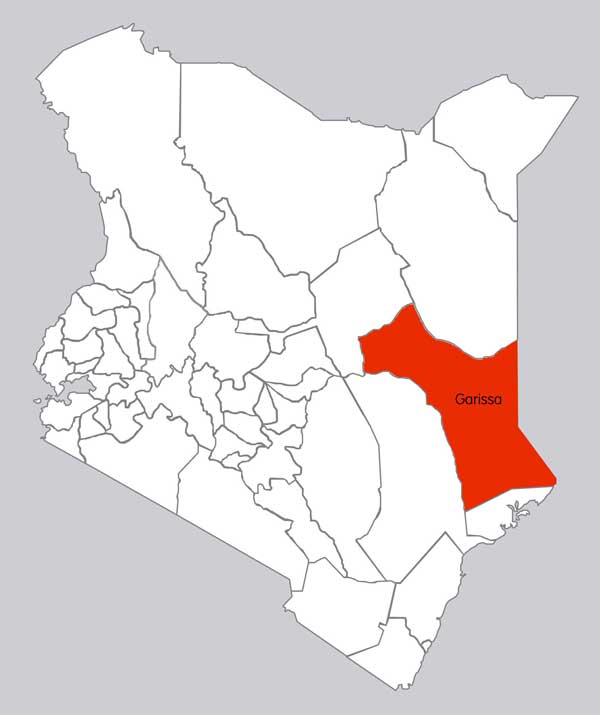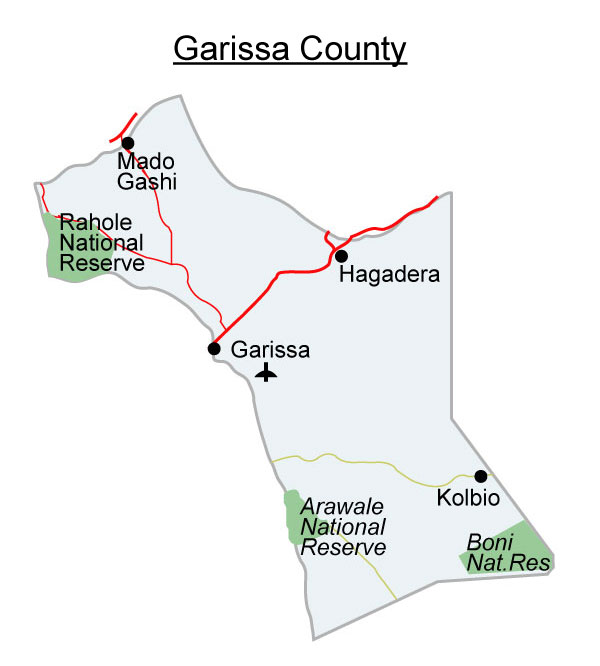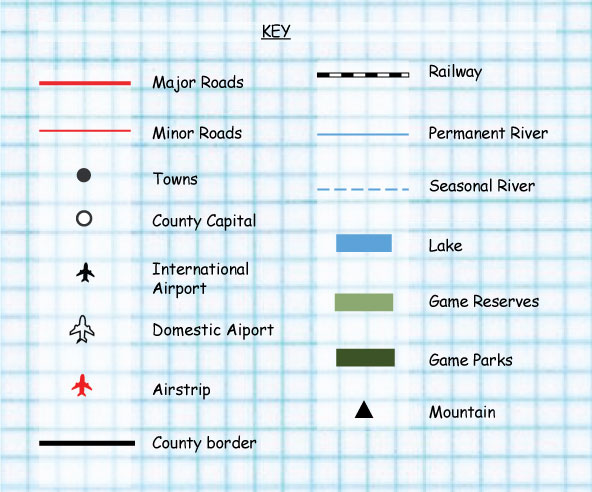Garissa County is an administrative county in the former North Eastern Province of Kenya. The County is most known for Garissa town which is almost the safest town in Eastern Kenya. Garissa County has a total population of approximately 623,060 persons. It borders the Republic of Somalia to the east, Lamu County to the south, Tana River County to the west, Isiolo County to the north - west and Wajir County to the north.

This area is basically flat and low lying without hills, valleys and mountains. The major physical features are seasonal Laghas and the Tana river Basin.
Rivers


Somalis are the predominant ethnic group. Most of Garissa's inhabitants are ethnic Somali, however, they are sub-divided into clans, with the Ogaden sub-clan of the Somali Darod especially well represented. There are also a small number of other minority ethnic groups, commonly referred to as corner tribes
The capital and largest urban area is Garissa. The large complex of refugee camps at Dadaab, with more than 260,000 Somalian refugees
Food
The evening meal includes beans, muffo (patties made of oats or corn) or a salad with more canjero. Somalis like spiced tea. Sheep, goat and camel's milk are also popular. Milk is the common drink for many rural Somalis and men who travel with the camel herds may drink up to nine liters a day.
Dressing
From there way of dressing the Islamic religion is clearly reviled which is almost the same way to how the Swahili people dress. Unlike Swahili men who wear a small white cap on their heads, the Somali men often wear a turban.
Songs and dances
Dhaanto is a style of traditional Somali music and folk dance. It is specific to certain Somali-speaking areas in the Horn region. The dance-song was revived during the Dervish period, when it was used to raise the 'spirts' of soldiers and was often sung on horseback.
Traditional medical practices
The main groups of diseases treated by traditional healers in the study area were not the most common diseases in the community. For instance, respiratory diseases, common infections, and skin diseases were less commonly treated by traditional healers. Mental disorders and magic beliefs, on the other hand were very often handled by the healers, especially in the rural area. Religious acts, traditional dancing and herbal medicine constituted the main and most commonly employed types of traditional treatment
Ceremonies
Somali names have three parts. The first name is the given name, and is specific to an individual. The second name is the name of the child's father, and the third name is the name of the child's paternal grandfather. Thus siblings, both male and female, will share the same second and third names. Women, when they marry, do not change their names. By keeping the name of their father and grandfather, they are, in effect, maintaining their affiliation with their clan of birth
There is no formal initiation ceremony for the Somalis.
They celebrated with muusiko or music to mark a successful harvest
Somalis use the word muusiko to discuss music. Somali music is pentatonic (a scale that uses five notes for octave, as opposed to the western seven-note heptatonic scale). The music functions as an accompaniment to poetry it is generally limited by constraints of the language, making the music predictable. The relationship between words and music can result in polyrhythms (when two or more rhythms are conflict), as the two parallel rhythms of the words and the music are performed simultaneously.
This was carried out in the evening during sunset it was educative and was meant to shape the morals of the young men and women in the village
Cash crops and food crops grown
Areas where the cash crops are grown
Types of livestock kept
Cattle, goats, sheep and camels are an important economic asset, especially among pastoral and agro pastoral livelihood groups. They provide sources of livelihood through milk and meat production and market sales. Fishing is also practiced long Tana River.
Identify areas where fishing is practiced in the COUNTY
Being a semi-arid region fishing is not popularly carried out here only along Tana River.
The county is refuge for a range of wildlife species including four globally threatened species: Hirola, Gravy Zebra, African Wild Dog and Cheetah.
Common herbivores in the region include hippopotamus, bush pig, warthog, buffalo, common duiker, topi and waterbuck. Common carnivores in the reserve are the vulnerable African Wild Dog and the aardwolf. Although extremely rare, African elephants are also present.
Products of traditional industries